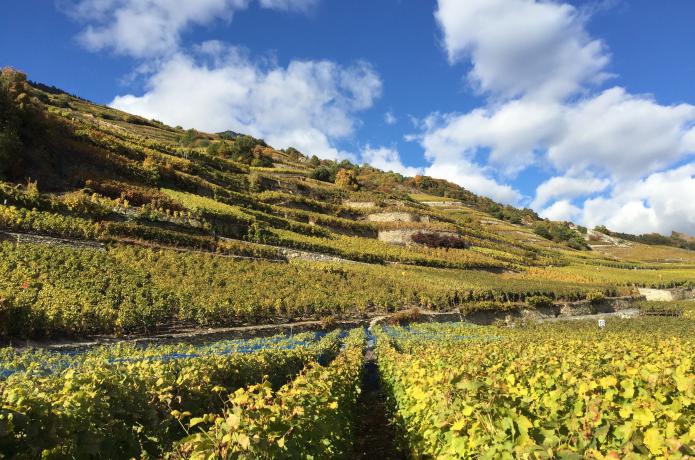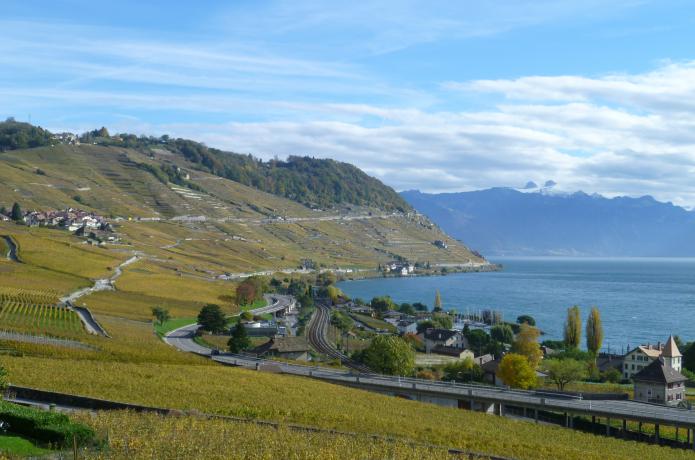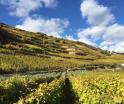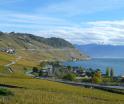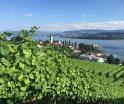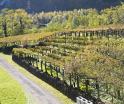Buyer’s guide to Swiss wine
- Monday 19 December 2016
By Sue Style, a freelance wine, food and travel writer, whose nine books include "A Taste of Switzerland"
An enigma to many, this Alpine nation at the heart of Europe produces some excitingly diverse quality wines, though many never make it beyond its borders. Sue Style takes us on a tour, and recommends 12 to try.
When I started exploring and writing about Swiss wines 30 years ago, few people had heard of them beyond the borders of this tiny, mountainous, landlocked country. Even today when I sing their praises – which I do at every available opportunity – I still get more than a few raised eyebrows.
Many people are unaware that wines are produced here. Others have heard of them, and maybe even unearthed a few jewels – a rare Petite Arvine from the Valais, perhaps, or a fragrant Pinot Noir from one of the cool- climate, German-speaking cantons; a complex Chasselas from the Lavaux vineyards that rise in majesty above Lake Geneva, or even a sleek Merlot from Italian-speaking Ticino. Inevitably the question of price comes up, swiftly followed by the complaint that Swiss wines are hard to find outside the country.
What’s new?
Wine has been made in Switzerland – as it has throughout Europe – for at least 2,000 years, but it’s the past 20 years that have seen the greatest changes. Two key developments came in the 1990s, which helped to push Swiss winemaking into another gear. Firstly, the federal government no longer agreed to buy up swimming pools (literally) of unsold Chasselas – neutral, mildly fizzy, inevitably designated as a vin de soif – at guaranteed prices, or oceans of Dôle, then a dull blend of Pinot Noir and Gamay that did few favours to either grape. In parallel, restrictions on foreign wine imports were lifted.
Producers were forced to conclude that, in a high-cost country, the only game in town was quality. Novel varieties have since been pioneered by the federal research station at Changins, ancient varieties resurrected and grapes new to Switzerland planted.
And while the older generation has been quietly investing its ever-strengthening Swiss francs in vineyards, barriques and even the occasional concrete egg fermenter, the younger generation of winemakers has been off on study trips and internships in France, Australia and New Zealand.
The net result has been a significant rise in quality and a welcome increase in the ‘tingle factor’ of Swiss wines. At a time when more and more people are interested in sampling curiosities and hunting down original, exciting wines that stand out from the crowd, these Alpine treasures are worth seeking out.
Regional essentials
Switzerland’s vineyards – 15,000 hectares in total; about half the planted area of Burgundy – are a magnificent patchwork of widely varying climates and terroirs, from the cool, verdant slopes of the northern cantons to the sunbaked Alpine terraces and parched heat of the Valais. Of the wines, 58% is red and 42% white, with Pinot Noir and Chasselas leading the pack respectively.
The country divides itself, wine wise, into six distinct regions (see box, right). Starting in the north, a virtual tour takes us first to the German-speaking region, which sprawls across gently hilly farming country running from Basel through Aargau, Zurich, Schaffhausen and Thurgau to Graubünden, tucked in beneath the Alps on the eastern border with Liechtenstein.
This German-speaking region turns out some of Switzerland’s most exciting and ageworthy Pinot Noir (sometimes labelled Blauburgunder) and Chardonnay. Growers acknowledge the role of climate change, which – with a little help from the Föhn, the warm wind that caresses the autumn vineyards – has brought increased ripeness to these northerly grapes. Meanwhile Müller-Thurgau, known in Switzerland as Riesling-Sylvaner, has upped its game, since many winemakers have reduced or eliminated their use of malolactic fermentation, giving a crisper profile to this otherwise mild-mannered wine.
Two white specialities to seek out in this region include the historic Räuschling, grown on the shores of Lake Zurich, and the vanishingly rare Completer, produced by Donatsch in Malans in tiny quantities and aged in used oak barrels to tame the grape’s natural acidity. ‘We’re the largest producers of Completer in the world,’ jokes Martin Donatsch – hard to dispute, since barely anyone else in the world makes it.
Across the Alps via the San Bernardino Pass is Ticino, Switzerland’s Italian-speaking Lake District. Though its steep terraces bask in sunshine much of the year, it has about twice the precipitation of neighbouring Valais. Merlot rules here, mainly as a single varietal but increasingly in Bordeaux-inspired blends. Straw-hatted Ivo Monti of Cantina Monti ferments his prize-winning wines to the strains of salsa and then soothes them gently with Bach in the barrel. ‘Merlot is a great soloist,’ he comments, ‘but in a blend you get the whole orchestra.’
Much to discover
Continuing around the country in a clockwise direction, we come to Valais, the country’s largest wine region, producing one-third of all Swiss bottlings. The climate was once described by poet Rainer Maria Rilke as a cross between Provence and southern Spain, with an annual sunshine rate to rival both.
Here, confirms Gilles Besse, oenologist at Domaine Jean-René Germanier in Vétroz and head of Swiss Wine Promotion, quality and professionalism are now the norm, and the days of ‘les vignerons du samedi’ (part-time grape-growers) a distant memory.
Valais is a happy hunting ground for lovers of rare grape varieties: Amigne, Arvine, Cornalin, Humagne Rouge and Heida have replaced swathes of Chasselas (known here as Fendant), alongside the well-established reds of Pinot Noir, Syrah and Gamay.
Following the Rhône downstream to Lake Geneva brings us to Vaud, the nerve-centre of Chasselas. If ever Switzerland had a signature grape, comments Swiss wine writer, author and consultant Chandra Kurt, Chasselas would be the obvious candidate. In the giddyingly steep vineyards of Lavaux, stacked above the lake from Vevey around to Lausanne, the grape over-delivers to give wines of rare depth and complexity.
On the red front, Pinot Noir and Gamay have a new challenger in Vaud: ‘Who would have thought we would ever grow Merlot here?’ wonders Epesses winemaker Luc Massy, who is not alone in acknowledging the extent to which global warming is changing the Swiss vineyard landscape.
At the western end of the croissant-shaped lake are the Geneva vineyards, formerly known for tank-loads of overcropped and underperforming Chasselas and dilute Gamay. The region has embraced the quality-over- quantity message with particular fervour: Jean-Pierre Pellegrin of Domaine Grand’Cour notes that while the total vineyard area here has not decreased, yields have halved – or in his case, quartered. The area is buzzing with young talent, such as rising star Sophie Dugerdil, who recently left a career as a teacher to take over the family vineyards and who is branching out with new varieties including Cabernets Sauvignon and Franc as well as Sauvignon Blanc.
With the tiny Three Lakes region, which straddles Switzerland’s linguistic French- German border in the far west, our Swiss wine tour comes full circle. Vines flourish on the shores of Lakes Neuchâtel, Biel/Bienne and Murten/Morat. Loyalties here lie with Pinot Noir – the ones from Neuchâtel frequently score in international competitions and in the annual Grand Prix du Vin Suisse – and Chasselas, which gives fine, nervy aperitif wines, quite unlike the fleshy, long-lived Chasselas of Lavaux.
High time to try
Swiss wines will never be exported in any quantity; currently only about 1.5% of production ever leaves the country. ‘Our problem is we can’t even produce enough for ourselves,’ comments Besse. This doesn’t mean Swiss winemakers are unaware of what’s going on beyond their borders. On the contrary: they travel – and taste – widely, drink fine wine from both the Old and the New World and draw inspiration from these international benchmarks.
The combined effects of the quality imperative, seasoned local palates and steady investment, along with Swiss meticulousness and an appetite for innovation (the country topped the WIPO Global Innovation Index again in 2016) have all borne fruit. Swiss wines are scaling new heights and catching the eye of curious wine drinkers.
And that pesky question of price? Good wine is expensive to produce, wherever it comes from. I’m increasingly convinced that top Swiss wine, when measured against quality wines from other countries, represents good value for money. To put price in perspective, you need to compare like with like.
So, the next time you reach for a New Zealand Pinot Noir, consider instead a Swiss Pinot from Neuchâtel or one of the northern cantons. If white Burgundy or the northern Rhône are your default choices, take a chance: look for a Chardonnay from Graubünden in the country’s southeast, or a Valais Syrah instead. And if you love Pomerol, take a punt on one of the top Merlots coming out of Ticino in the far south, or from Geneva.
Swiss grape varieties
[Petite] Arvine Thrilling, newly trendy white variety indigenous to the Valais. Wines vary from lipsmackingly dry with grapefruit tones and a characteristic salty finish, to lusciously sweet and highly concentrated from late- harvested grapes
Chasselas (Fendant) Typically gives delicate, low-acid, low-alcohol wines with a slight CO2 prickle. Planted in prime sites (notably Lavaux), it can give wines of distinction and subtle depth
Heida (Païen) The Savagnin grape of Jura fame, now firmly established in the Valais where it gives grand, spicy whites of great distinction
Amigne Another ancient white variety indigenous to the Valais. Small-berried, late-ripening, giving luscious, honeyed wines of varying sweetness levels
Pinot Noir (Blauburgunder) Switzerland’s most widely planted grape, the best traditionally from Graubünden in the east and Neuchâtel in the west, with increasingly impressive examples from Aargau, Zurich and Schaffhausen.
Humagne Rouge Correctly known as Cornalin [d’Aoste]. Distinctive, late-ripening Valais variety; can have a rustic character and pronounced tannins, but in the right hands it gives scented, cherry-red wines that can age with elegance.
Merlot Arrived in Ticino from Bordeaux in 1906 and now occupies 90% of the canton’s vineyard area. Made both as a varietal and in Bordeaux-style blends, plus small amounts vinified as white wine.
Switzerland’s six wine regions
Valais (33% of total wine volume produced) In the heart of the Alps, with vineyards extending over 100km along the Rhône river.
Vaud (25%) Predominantly along the shores of Lake Geneva, with some vineyards at the southwestern end of Lake Neuchâtel.
German-speaking region (19%) Widely scattered across 17 German-speaking cantons from Basel and Aargau in the northwest via Zurich, Schaafhausen and Thurgau, to St Gallen and Graubünden in the east.
Geneva (10%) In the foothills of the sub-Alpine Jura mountains and both banks of the Rhône as it leaves the western end of Lake Geneva.
Ticino (7%) On the southern side of the Alps close to the Italian border, with abundant sunshine tempered by lake-effect rain from its proximity to Lakes Lugano and Maggiore.
Three Lakes (5%) Mostly on the slopes of the Jura along the northern banks of Lake Neuchâtel, with the balance on the equivalent shores of nearby Lakes Biel/Bienne and Murten/Morat.




